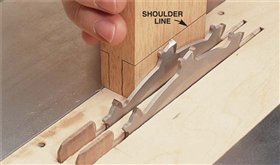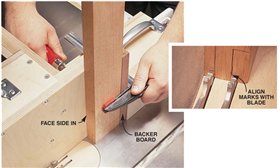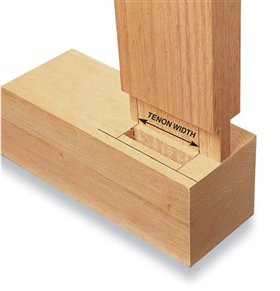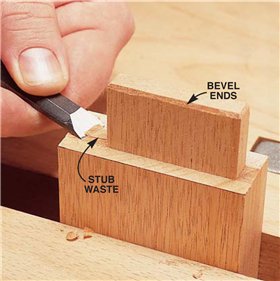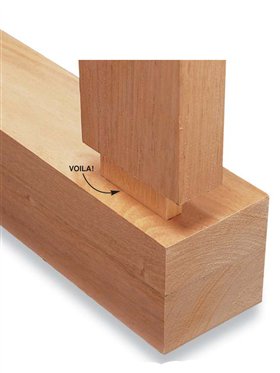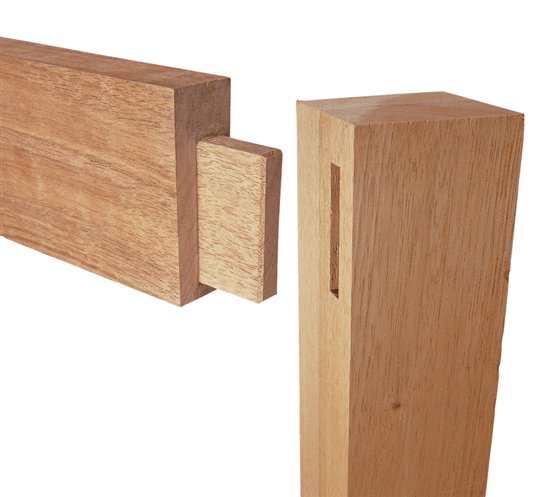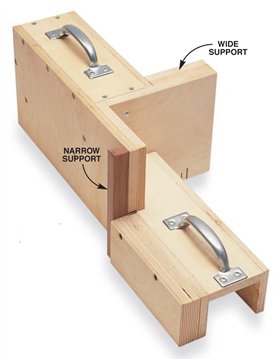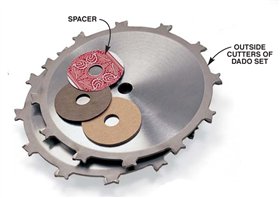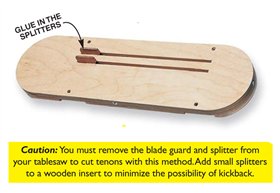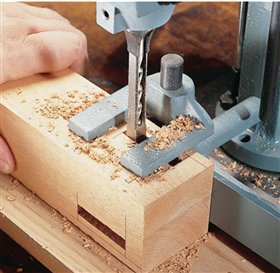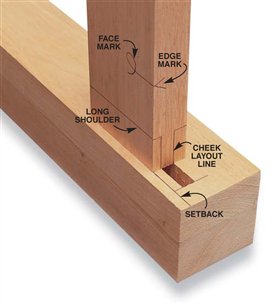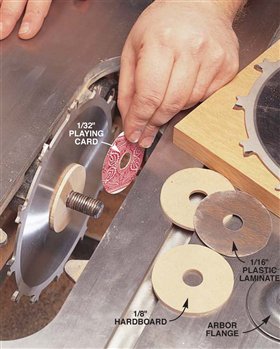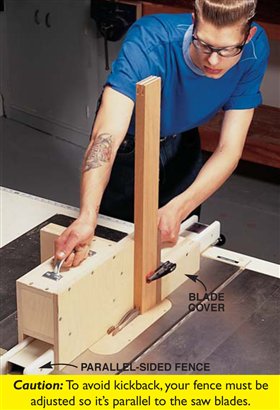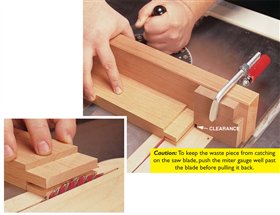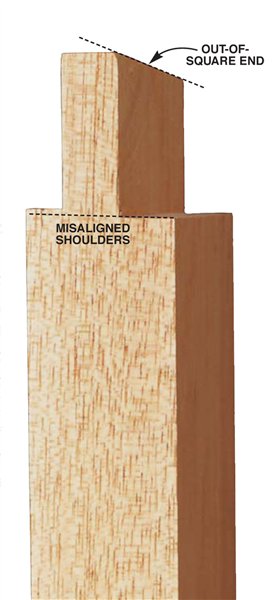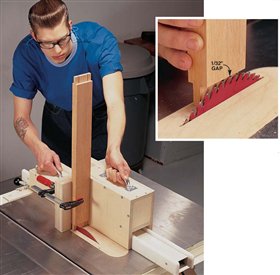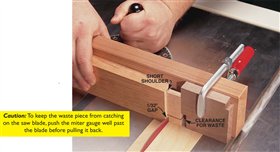We may receive a commission when you use our affiliate links. However, this does not impact our recommendations.

Foolproof Tenons
Two blades and
a rock-solid jig guarantee success.
By Tom Caspar
Mortise and tenon joinery is the
heart of many classic furniture
projects. It’s an incredibly strong,
time-tested method of connecting
boards. Making these precisely fit
joints can be fussy and demanding
work. But it doesn’t have to be.
There are at least a dozen ways
to cut tenons.We’ve chosen a
technique that delivers the goods
every time, whether you’re a
beginner or seasoned pro. It’s
simple, safe and economical. Best
of all, this technique will save you
a lot of set-up time. Rather than
fit tenons by trial and error for
each project, you can easily
reproduce the same size tenons,
time after time.
What you’ll need:
A Tenoning Jig
You can buy a commercial jig or make a better one
yourself. Looking for a better mousetrap, we
designed a heavy-duty jig that slides on top of a
tablesaw fence. (Your fence must have parallel
sides for this jig to work, however. If you have an
L-shaped fence, see the jig in AW #81, page 55.)
Features:
– Large capacity.The 8-in.-tall sides are high
enough to support a rail up to 36-in. long.
– Dedicated sides. No commercial jig offers this
handy feature. The left side supports the edge of a
rail; the right side supports the face.
– No tear-out. None.A backer board prevents annoying
tear-out when you rip the tenon cheeks. It’s easy to replace
the backer board when you change settings.
– Safe operation. Generous handles keep your hands out of
harm’s way.An oversize block behind the backer board covers
the saw blade after it makes the cut. |
|
Click on any image to view a larger version.

|
Two Saw Blades
Make smooth-sided tenons with a
pair of matched sawblades
separated by spacers.You can
use the outside cutters of a
dado set or two carbide-tipped
7-1/4-in. circular saw blades
(about $8 each). |
|
 |
A Zero-Clearance
Insert with Splitters
Make a dedicated insert for your
tablesaw so your tenon cutting is as
safe as possible.Although the parts
you cut will be clamped to the jig,
this insert provides additional
support from underneath. |
|
 |
Build the Jig
Our jig rides on top of your tablesaw and is guided by the
fence.The fit between the sides of the jig and the fence has
to be just right. If it’s too tight, you’ll have to push too hard.
If it’s too loose, your tenons won’t be straight.Here are some
tips to make building and fitting the jig easier:
– Drill all the 13/64-in.-dia. clearance holes in the jig with
a drill press (Detail 1, below).
– Creep up on the width of boards C, D, and E. For your
jig to slide properly, the right fit is a matter of 64ths of an inch.Rip the boards slightly oversize, then clamp them
between the faces of the jig and try sliding the jig along
your saw’s fence.
– If your jig is too tight, shim the edges of boards C, D and
E with masking tape. Don’t laugh! It’s an effective way to
fine-tune the fit.
– Clamp the jig together and make sure it’s square to the
top of the tablesaw before drilling any pilot holes and
driving in the screws. Don’t glue the jig together.You may
need to disassemble it later to adjust the fit. |
|

Cut the corners of the jig on the tablesaw (Detail 2).
Stop the cut at the pencil line and withdraw the board.
The bottom side of the board may be overcut, but
that’s OK. It’s only a jig! |
Getting Started
Mill all your stock straight and square, and boldly mark the face and edge of each piece.
Usually the face side is the outside of a rail and the reference edge is the top of a rail.
1. Make the mortises first. It doesn’t matter
whether you use a mortising machine, a router or a
drill press. It’s far easier to fit a tenon into a mortise
than it is to customize a mortise to fit a tenon. |
|
 |
2. Lay out the
tenon’s cheeks
directly from the
mortise.This joint
won’t be flush, so first
you must draw a line representing the setback
of the rail from the front of a leg or a stile.
Draw lines across the face and edge of the rail
representing the shoulders of the tenon so you
can set the height of the cut on the tablesaw. |
|
 |
3. Install homemade spacers
between the saw blades.You’ll need
three different kinds of spacers to fit
every size tenon (approximately
1/8 in., 1/16 in. and 1/32 in. thick). Make
them the same diameter as the flange
on your saw’s arbor.The best way to
figure out the right mix of spacers is
by trial and error, making tenons in
scrap wood. Fortunately, if you save
and label the spacers you should only
have to go through this process once. |
|
 |
Cut the Cheeks
One pass through your ganged-up saw blades and you’ve cut both sides of the tenon.
4. Raise the blades to
match the shoulder
line on your rail. |
|
 |
5. Clamp the rail to the tenoning jig,
face side in, and adjust the tablesaw’s
fence so the layout marks line up with
the two saw blades. |
|
 |
6. Rip the cheeks. Slide the jig through the cut,
then pull the jig back and unclamp the rail. Rip all
your tenons. Make sure the marked face of each of
your rails is the face you clamp against the jig.
When you’re done, remove the double blades
from the tablesaw and install a crosscut saw blade. |
|
 |
Cut the Long Shoulders
Make perfect, tight-fitting shoulders with a crosscut saw blade.
7. Cut the long shoulders.
Set up your miter gauge
with a fence, and clamp a
stop block to it. Raise the
stop block above the waste
piece so the waste won’t
get trapped.
Cut all the shoulders on
the face sides of the rails
first.Then readjust the
height of the blade, if
necessary, to cut all the
shoulders on the back sides
of the rails.
Raise the blade
so it barely touches
the cheek. |
|
 |
Oops!
My shoulders are drooping!
I thought they were going to
line up just right but somehow
they became offset. I checked
the ends of the rail with an
accurate square, and wouldn’t
you know it, they were off.The
culprit is my miter gauge. It
wobbles in the slot, so I don’t
get an accurate 90-degree cut
every time.And if the shoulder
cuts (Photo 7) aren’t exactly
square, the shoulders won’t
line up at the edges.
The fix? I bought a premium
miter gauge ($100 to $170) that fits
tighter in the slot. Rather than
toss out the rails, I re-cut both
ends as little as possible and
re-cut the shoulders.Now my
project is a bit smaller than
originally planned, but the
joints are perfect. |
|
 |
Cut the Tenon’s Width
Make two rip cuts on the right side of the tenoning jig.
They establish the tenon width.
8. Mark the width of
the tenon directly
from the mortise. |
|
 |
9. Rip the tenon to width. First,
move the fence to the left side of
the saw blade. Clamp the rail to
the right side of the tenoning jig
and adjust the fence until the
blade lines up with the marks.
Raise the
blade about
1/32-in. lower
than the
shoulder to
avoid cutting
into it. |
|
 |
Cut the Short Shoulders
Sawing all four shoulders flush isn’t realistic. Don’t push your luck! Finish them with a sharp chisel.
10. Rough cut the waste
pieces on the tablesaw.
Position the stop block so
the short shoulders are
proud by 1/32-in. or so.
In theory, it’s possible to
make this cut precisely
flush, but in practice it’s
darned hard. Don’t risk
messing up your crisp
shoulders! |
|
 |
11. Remove the stub waste
with a chisel.This paring
requires a keen edge, but if
you cut too deep, it won’t
show. Bevel the ends of the
tenon with a file so it will
easily fit in the mortise. |
|
 |
12. Test the fit. If your tenon
is too wide to fit into the
mortise, it’s easy to go back
and trim off one side with
the tenoning jig. If it’s too
loose, glue the waste pieces
back on and cut again. |
|
 |
Product Recommendations
Here are some supplies and tools we find essential in our everyday work around the shop. We may receive a commission from sales referred by our links; however, we have carefully selected these products for their usefulness and quality.
